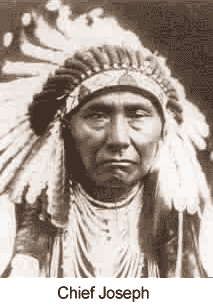A certain Pacific Northwest tribe of Shahaptin stock was dubbed the Nez Percé by French-Canadian trappers, probably because some of the natives sported nose ornaments. The Lewis and Clark Corps of Discovery encountered them in 1805. The Nez Percé then comprised some 6,000 people.
A famous 1877 fighting retreat led by Chief Joseph¹ (b. 1840), Chief White Bird, and others turned out to be the final and most extended Indian war in the region.
 The background to the Nez Percé War is a lamentably familiar situation. In 1877, President Ulysses S. Grant opened the Nez Percé homeland, the beautiful Wallowa Valley of Eastern Oregon, to white settlement. In addition, the U.S. government demanded that all roaming Nez Percé bands promptly move onto the Lapwai reservation in present-day Idaho. Chief Joseph, a dignified, well-spoken man, was selected to meet and discuss the demand with one-armed Civil War veteran Brigidier General Oliver O. Howard. There was little discussion; Howard delivered a 30-day ultimatum with a threat to comply, or else. The bands reluctantly began to move away.
A spark, then traveling flames
Growing tension spurred a group of young Nez Percé warriors to stage unauthorized, murderous raids whose targets were settlers along the Salmon River. The elders first hid the firebrands, but Joseph knew that retribution would shortly follow and he reluctantly prepared for war.
A hurriedly assembled U.S. battalion marched on the main Nez Percé camp. On June 17, a force of 300 Indians beat off² the soldiers at White Bird Canyon in Idaho. However, the Nez Percé fled, knowing they could not engage Howard's full army.
Waging a series of battles against the pursuing Howard (and later, Colonel Nelson A. Miles) that summer, Chief Joseph, Chief Ollokot, and others led about 800 people on a remarkable escape attempt southeast through Montana, then back north across present-day Yellowstone Park. The Indians traveled more than 1,700 miles while outmaneuvering 10 units of pursuing U.S. soldiers.
Thinking they had finally shaken off their pursuers, the Indians stopped for badly needed rest near the Bear Paw Mountains in Montana. They were roughly 40 miles from the Canadian border; crossing it meant safety.
However, Miles had led his troops on a brilliant 160-mile forced march to catch the Nez Percé, and he attacked them on September 30. After a five-day battle, the Indians fought the soldiers to a stalemate, but their ponies were stampeded and Howard's reinforcements were closing fast. Joseph and his weary band finally capitulated. White Bird refused to surrender and escaped to Canada with some of the band.
Joseph's famous surrender oration was recorded and translated as follows:
The background to the Nez Percé War is a lamentably familiar situation. In 1877, President Ulysses S. Grant opened the Nez Percé homeland, the beautiful Wallowa Valley of Eastern Oregon, to white settlement. In addition, the U.S. government demanded that all roaming Nez Percé bands promptly move onto the Lapwai reservation in present-day Idaho. Chief Joseph, a dignified, well-spoken man, was selected to meet and discuss the demand with one-armed Civil War veteran Brigidier General Oliver O. Howard. There was little discussion; Howard delivered a 30-day ultimatum with a threat to comply, or else. The bands reluctantly began to move away.
A spark, then traveling flames
Growing tension spurred a group of young Nez Percé warriors to stage unauthorized, murderous raids whose targets were settlers along the Salmon River. The elders first hid the firebrands, but Joseph knew that retribution would shortly follow and he reluctantly prepared for war.
A hurriedly assembled U.S. battalion marched on the main Nez Percé camp. On June 17, a force of 300 Indians beat off² the soldiers at White Bird Canyon in Idaho. However, the Nez Percé fled, knowing they could not engage Howard's full army.
Waging a series of battles against the pursuing Howard (and later, Colonel Nelson A. Miles) that summer, Chief Joseph, Chief Ollokot, and others led about 800 people on a remarkable escape attempt southeast through Montana, then back north across present-day Yellowstone Park. The Indians traveled more than 1,700 miles while outmaneuvering 10 units of pursuing U.S. soldiers.
Thinking they had finally shaken off their pursuers, the Indians stopped for badly needed rest near the Bear Paw Mountains in Montana. They were roughly 40 miles from the Canadian border; crossing it meant safety.
However, Miles had led his troops on a brilliant 160-mile forced march to catch the Nez Percé, and he attacked them on September 30. After a five-day battle, the Indians fought the soldiers to a stalemate, but their ponies were stampeded and Howard's reinforcements were closing fast. Joseph and his weary band finally capitulated. White Bird refused to surrender and escaped to Canada with some of the band.
Joseph's famous surrender oration was recorded and translated as follows:
"I am tired of fighting. Our chiefs are killed.... The old men are all killed.... It is cold and we have no blankets. The little children are freezing to death. My people, some of them, have run away to the hills and have no blankets, no food; no one knows where they are, perhaps freezing to death. I want time to look for my children and see how many of them I can find. Maybe I shall find them among the dead. Hear me, my chiefs, I am tired; my heart is sick and sad. From where the sun now stands, I will fight no more forever."The aftermath Joseph was assured that the Nez Percé would be permitted to return to a remnant of their home country in Oregon. However, political pressure from the Northwest forced another outcome: exile to Indian Territory (present-day Oklahoma). In 1885, some of the Nez Percé were allowed to move onto the Lapwai Reservation in Idaho, but Joseph and others were sent to the Colville Reservation in northeastern Washington. Chief Joseph died and was buried there in 1904.